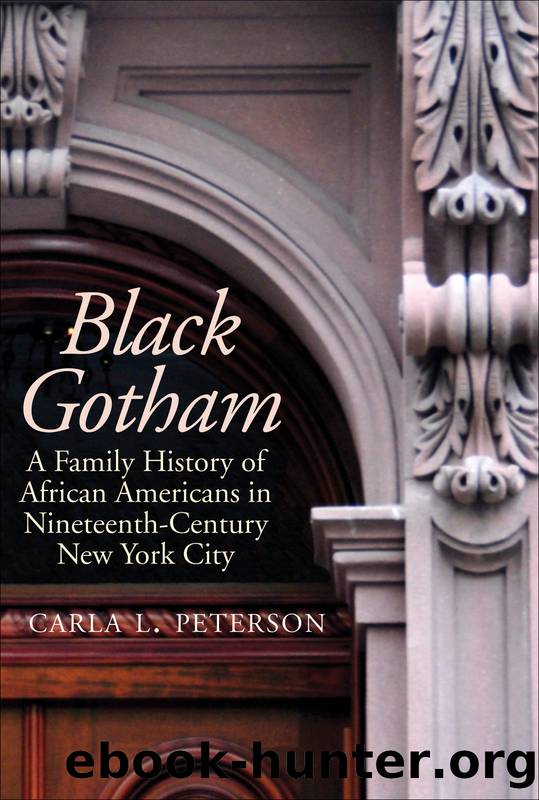Black Gotham: A Family History of African Americans in Nineteenth-Century New York City by Carla L. Peterson

Author:Carla L. Peterson [Peterson, Carla L.]
Language: eng
Format: epub
Tags: Social Science, Ethnic Studies, African American Studies, history, United States, State & Local, Middle Atlantic (DC; DE; MD; NJ; NY; PA), social history
ISBN: 9780300162554
Google: ttbk_hvivVgC
Publisher: Yale University Press
Published: 2011-01-01T00:24:45.516522+00:00
CHAPTER SEVEN
The Draft Riots
JULY 1863
IT WAS A LOTTERYâthe simple act of reading names drawn from a barrelâthat sparked the riot. Early on the morning of Monday, July 13, 1863, hundreds of white workers from the Ninth Ward took to the streets. The weather was infernally hot. In his diary, George Templeton Strong described the day as a âdeadly muggy sort with a muddy sky and lifeless air.â It matched the surly mood of the crowd. Rather than proceed to their places of employment, they converged on Central Park where they held a brief meeting. Holding high âNo Draftâ placards, they then descended on the Provost Marshalâs office in the Ninth Ward at Third Avenue and Forty-seventh Street, where the lottery was about to start. At ten-thirty, the Provost Marshal began calling out names as they were taken from the wheel. As he read off the last one, a stone came crashing through the window, and the destruction began. The crowd smashed the wheel, scattering the pieces of paper on which the names had been written. They destroyed all the furnishings and set the building on fire. The New York City draft riots, the largest incident of civil disorder in the nation to that date, had erupted.1
Two years earlier, on April 12, 1861, Confederate forces had launched an attack on the Union army at Fort Sumter, South Carolina. On April 15, President Lincoln declared a state of insurrection in the South and called for seventy-five thousand volunteers to put it down.
As the war progressed, the federal government became desperate for more soldiers and decided to enact a draft law. In March 1863, Congress passed a National Conscription Act decreeing that all male citizens (by definition white) between the ages of twenty and thirty-five were to be enrolled in the military, and a lottery then conducted to determine who would actually serve. The act granted federal officials considerable authority to intrude in the daily life of the citizenryânamely, the power to conduct house-to-house visits for enrollment purposes and to arrest those who resisted. Stunningly, it also included a provision exempting from service those who could offer an acceptable substitute or pay three hundred dollars. It was the poor, not the rich, who were to fight Lincolnâs war.
Of all the stories in this book, the history of the New York draft riots is by far the best known. Itâs been told over and over again in print and on screen. Perhaps because of its violence. Perhaps because of the innocence of the victims. Perhaps because of the fiendishness of the mob. And thereâs a written record.
For the next week, white and black New Yorkers alike could follow the progress of the riot in their newspapers. In addition to government, police, and eyewitness accounts, itâs the city papers that have left the most extensive paper trail. Philip and his friends found heartfelt reports of the horrors unfolding in the streets in the Tribune, the Times, antislavery papers like the Liberator and National Anti-Slavery Standard,
Download
This site does not store any files on its server. We only index and link to content provided by other sites. Please contact the content providers to delete copyright contents if any and email us, we'll remove relevant links or contents immediately.
Harry Potter and the Goblet Of Fire by J.K. Rowling(3107)
Never by Ken Follett(2923)
Unfinished: A Memoir by Priyanka Chopra Jonas(2922)
Machine Learning at Scale with H2O by Gregory Keys | David Whiting(2335)
The Man Who Died Twice by Richard Osman(2317)
Fairy Tale by Stephen King(2107)
Will by Will Smith(2085)
Rationality by Steven Pinker(1783)
The Storyteller by Dave Grohl(1676)
The Dark Hours by Michael Connelly(1590)
The Dawn of Everything: A New History of Humanity by David Graeber & David Wengrow(1584)
The Stranger in the Lifeboat by Mitch Albom(1568)
Cloud Cuckoo Land by Anthony Doerr(1455)
New Morning Mercies: A Daily Gospel Devotional by Paul David Tripp(1410)
Friends, Lovers, and the Big Terrible Thing by Matthew Perry(1356)
The Becoming by Nora Roberts(1349)
Crying in H Mart by Michelle Zauner(1340)
Einstein: His Life and Universe by Walter Isaacson(1327)
A Short History of War by Jeremy Black(1313)
